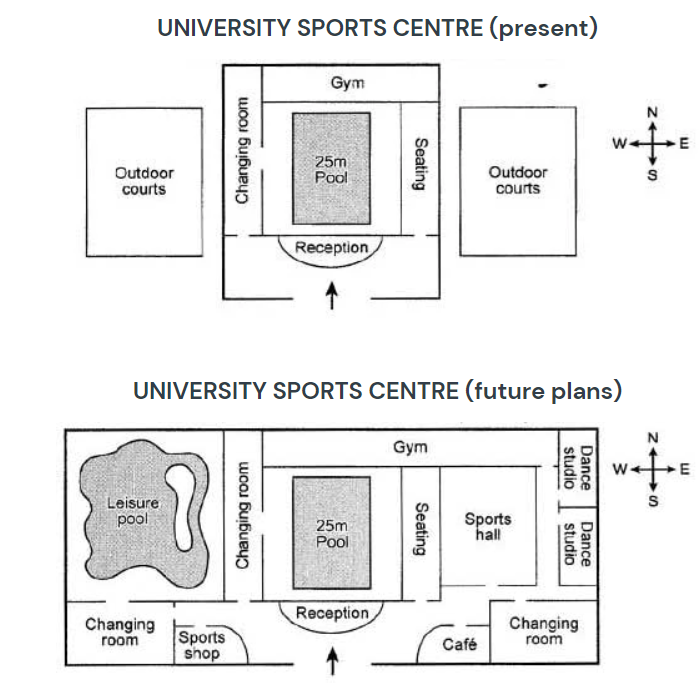IELTSライティング・アカデミックのタスク1は、図表、地図、プロセスの内容をリポートする課題です。
出題形式は大きく分けて3つあり、どの形式の課題が出題されるかは試験を受けるまでわからないので、すべてのタイプについて対策を取ることが大切です。
この記事では、地図問題について概要と解答方法を紹介します。
ライティングタスク1の地図問題
IELTSライティングのタスク1では、テーブルや棒線グラフなどの図表の解析が多く出題されます。出題タイプは大きく分けて次の3つです。
- 図や表の解析
- 地図問題/都市や公共施設の移り変わり・変化
- ダイアグラム・プロセス問題
地図問題は、都市(公園や病院などの公共施設も含む)の移り変わりや変化をリポートする形式の問題で、最近では出題頻度が増加しています。
地図問題や都市の移り変わに関する問題の解答は、図表の解析よりも易しく、比較表現などを使用して特徴をまとめる必要はありません。
便利な表現や言い回し、解答の書き方を覚えてしまえば、スムーズに解答できるため時間の短縮にもつながります。
解答の構成
タスク1の解答は、どのタイプの課題でも、イントロ ➡ 概要(まとめ) ➡ 詳細1 ➡ 詳細2 の4段落構成で書きます。
| 段落1 | イントロ:問題文のパラフレーズ (書き換え) |
| 段落2 | 概要: 全体をざっくりと説明する (メインの特徴を2つほど挙げて、2, 3文でまとめる) 地図問題では、大まかな変化を簡潔に述べること ※ここでは詳細は述べません |
| 段落3 | 詳細1: 特徴を細かく述べる 地図問題では、一番目立つ変化から順序よく詳細を述べる |
| 段落4 | 詳細2: 段落3以外の特徴を細かく述べる 地図問題では、残りの変化を詳細に述べる |
地図問題の3つのパターン<時制の違い>
地図問題の時制を分類すると、3つのパターンに分けることができます。
- 過去から過去への変化
- 過去から現在への変化 (BeforeとAfterの変化)
- 現在から未来の変化
ほとんどの問題は2つの地図を比較しますが、問題によっては3つの地図が記載される場合もあります。
地図問題について解答する際は、時制に注意しましょう。
中には、非常にまれに出題される特別なパターンの地図問題があります。以下の記事を参考にしてください。


時制の判断方法
解答する際には、地図の年代を確認し、どの時制で解答するかを適切に解答しましょう。
過去から過去への遷移
地図の年代が過去から過去を示していれば、時制はすべて過去形に統一しましょう。
過去完了を使う必要はなく、文法ミスによる減点につながることもありますので注意しましょう。
過去から現在への遷移
地図の年代が過去から現在へ変化している場合は、解答は現在完了で記述します。
現在から未来への遷移
現在の地図から未来を予想している地図が表示されている場合には、予想未来の時制を使用します。
それぞれの時制について、詳しい説明は以下の記事を参考にしてください。


例題と解答例
ここでは、例題と解答例を参考に、どの時制でレポートを記述すればよいかを紹介します。
地図問題パターン1:過去から過去への変化
まずは、過去から過去への変化を表す(過去形で記述する)例題を紹介します。
例題
The diagram shows the changes that had taken place at West Park Secondary School since its construction in 1950.
Summarize the information by selecting and reporting the main features, and make comparisons where relevant.


パターン1の解答例
イントロダクション
The maps illustrate how a secondary school called West Park Secondary School changed over a period of 60 years from 1950 to 2010.
まとめ
Overall, although the main building itself remained the same, the school had undergone a significant transformation with the emergence of new facilities by 2010
※ “by 2010” のように「~までには」という表現を使用した場合、必須ではありませんが、現在完了形を使用することもできます。
詳細1
From 1950 to 1980, while the main building and the play ground were still there, the houses were demolished to make way for an additional block of the school and a new car park whereas a sports field replaced the old farmland.
詳細2
By 2010, the science block and the school had been stayed unchanged. The car park was widened and replaced the area of the sports field, leading to the sports field being diminished and moved into a small part of the playground area. As a result, the playground was reduced in size.
地図問題パターン2:過去から現在への変化
過去から現在への変化(BEFORE〈過去形〉とAFTER〈現在形〉の変化)では、現在形を使用して解答します。
例題
The maps below show changes in the Spanish city of Castellon in recent times.
Summarize the information by selecting and reporting the main features, and make comparisons where relevant.


パターン2の解答例
イントロダクション
The two maps show the changes which have taken place in the town of Castellon between the year 2000 and today.
まとめ
In general, it appears that Castellon has become a much more modern city, with far more shopping and transport facilities.
詳細1
One interesting change is that a new tram line has been built connect the university with the town centre. In 2002, there was not any accommodation for students, but a hall of residence has been built near the university. Another striking change is that the old market in the west of the city has been knocked down to make way for new shops. A complete new covered market has also been built on the other side of town.
詳細2
If we look at the port area, it has been pedestrianized since 2000, and a range of entertainment facilities have been built, such as cinema, bars and clubs. The north-east of the city used to be a green area with lots of trees, but the trees have been cut down and a new shopping complex has been constructed. A final interesting development has been the introduction of a bike-rental scheme in the city centre.
地図問題パターン3:現在から未来の変化
現在から未来の変化を表している地図では、未来予想系を使用して解答します。
例題
The plans below show the layout of a university’s sports centre now, and how it will look after redevelopment.Summarize the information by selecting and reporting the main features, and make comparisons where relevant.


パターン3の解答例
イントロダクション
The diagrams detail the present construction of a sports centre and plans for its renovation.
まとめ
Overall , it is immediately apparent that there are plans to remove the outdoor courts and expand the gym with additional facilities, although the center pool will remain unchanged.
詳細1
Looking the both maps closely, the outdoor courts in both sides of the gym are planned to be demolished in favour of a leisure pool and sports hall. The entire main building will not undergo any modification including the changing room, reception and seating area. The only exception is that the gym on the northern end of the building is going to be enlarged eastwards and connect with two new adjoining dance studios.
詳細2
When we look at other changes, in the southeast of the planned sports hall, the university will add an additional changing room and a cafe to the west. A new sports shop will open next to the changing room in the south west .
ライティングタスク1の制限時間20分の使い方
IELTSのライティングは、とにかく時間との戦いです。解答を時間通りに終えるためには、書き始める前にしっかりとしたプランニングを行うことが非常に重要です。
考えがまとまっていないまま書くと、反復表現が多くなる、段落にまとまりがなくなる、書き直しが多くなる、など、時間を無駄に使ってしまうことにつながります。しっかりとしたアウトラインを立ててから書き始めましょう。
タスク1のアウトラインの作り方
解答の前に、次の手順でアウトラインを作成しましょう。
- まずは問題文を読み、どのタイプの課題かを把握しましょう。
- 次に「どの時制で統一するか」を決めます。
- 時制を決めたら、ざっと見た特徴を考えましょう。(まとめに必要な特徴を2つ挙げる)
- 大まかな特徴が分かったら、詳細点をいくつか箇条書きにしましょう。
上記の流れでアウトラインの作成が完了したら、これを基にして書くことに専念しましょう。
地図問題の注意点
地図問題を解答する際は、次の3点に注意しましょう。
- 方角を表す言葉を使用する
- 時制を統一する
- 受動態を使用する
方角を表す言葉を使用する
地図問題なので、解答には「North/South/West/East」といった方角を表す言葉を使用しましょう。
「上、下、右、左」で場所を指し示さないように注意が必要です。
時制を統一する
解答の時制が統一されるように注意しましょう。地図を読み取る際には、過去から過去なのか、過去から現在なのか、現在から未来なのか、に注目して時制を選びましょう。
出題が多いのは過去形で書く問題ですが、他の時制でも解答できるように慣れておきましょう。
受動態を使用する
地図問題では、建物や施設がどのように変化するかを述べることが多く、人が動作主になることが少ないです。
受動態をうまく使い、具体的に記述できるように解答しましょう。
地図特有の表現 🗺
ここでは、地図問題に使える便利な表現を紹介します。課題の内容が変わっても使いまわすことができるため、ぜひ覚えておきましょう。
動詞
通常、受動態で使う動詞
- be built / constructed:~(建築物)が造られる
【例】A café was constructed in the north of the park. - be developed: ~が開発される
【例】Residential area has been developed. - be replaced by:に取って換わる
【例】The fountain was replaced by a large square rose garden. - be turned into:~に変わる、なる
【例】This street will be turned into a pedestrian precinct - be demolished:が取り壊される
【例】An old house destined to be demolished. - be knocked down / be pulled down / be taken down / be tore down:~が取り壊される
【例】The independent shops are taken down to make way for a big shopping mall. - be converted / be transformed :~に変化する
【例】The village was transformed into a modern city. - be cut down:~が伐採される
【例】The trees were cut down in order to make a parking lot. - be updated:~が改善される・アップデートされる
【例】The concert hall is going to be updated to a larger auditorium. - be modernized:~近代化される
【例】The library has been modernized to increase users. - be enlarged ~が拡大される
【例】The gym was enlarged southward. - be extended:~〈土地・建物・領土などを〉を広げる、拡張する;〈事業・勢力などを〉拡大する
【例】The main building was extended to have more rooms. - be relocated to:~に移転する、移る
【例】The pool was relocated to the west side of the building.
通常、能動態で使われる動詞
- be newer and more modern:新しく・モダンになる
【例】The hotel has become newer and more modern. - be larger / be bigger:大きくなる
【例】The playground was larger than it used to. - expand:拡大する
【例】The gym is going to expand to the south. - double:二倍になる
【例】The building has doubled in size. - undergo:経験する、受ける
【例】The area has undergone extensive development.
その他の表現
- make way for A:Aのために余地を作る
【例】the outdoor courts were demolished to make way for new dance studios. - There used to be A but:Aがそこに存在したが
【例】There used to be a big farmhouse, but it was converted to a church. - One of the noticeable changes is:一つの顕著な変化は
【例】One of the noticeable changes is development of skyscrapers.
場所や方角の表し方
地図問題では、場所や方角を記述することが多々あります。以下の表現も覚えて、便利に使用しましょう。
- The forest to the south of the river was cut down.
- A golf course was constructed to the north of the airport.
- The houses in the south-west of the town were demolished.
- The green fields to the north-west of the city were redeveloped as a park.
- The airport in the centre of the city was relocated to the north-east of the river.
- The school to the south-east was knocked down and a new one built to the east of the forest.
場所や方角を表す前置詞
- Dramatic changes took place in the city centre.
- To the south of the town, there is a golf course surrounded by trees.
- A new school was built next to the swimming pool.
- The old road running from north to south was replaced by a new motorway.
- A marina was built on the banks of the river.
- The children’s play area is located just off the marked trail.
- In front of the school, a supermarket was built.
- the hotel is situated adjacent to the library.
地図特有の表現方法 練習問題
( )に当てはまる英単語を考えてみましょう。
※問題をクリックすると解答が表示されます
Q1. The old house ( ) ( ) and a new one has been ( ).
古い家は取り壊されて、新しい家が建設された。
A1. The old house was demolished and a new one has been constructed.
Q2. There ( ) ( ) ( ) a supermarket in 1990, but it was ( ) by a theater.
1990年にはスーパーマーケットがあったが、映画館に取って代わられた。
A2. There used to be a supermarket in 1990, but it was replaced by a theater.
Q3. A sport centre used to ( ) ( ) to the south of the town but was ( ) to the north-west.
スポーツセンターがかつて町の南にあったが、北西に移された。
A3. A sport centre used to be located to the south of the town but was relocated to the north-west.
Q4. One of the ( ) ( ) is that the main campus has ( ) renovation.
一つの顕著な変化は、メインキャンパスが改築中であることだ。
A4. One of the noticeable changes is that the main campus has undergone renovation.
Q5. The trees ( ) ( ) ( ) and the areas has become a residential area.
木々は伐採され、その地域は住居エリアとなった。
A5. The trees were cut down and the area has become a residential area.
Q6. The parking lot ( ) ( ) to accommodate more parking.
駐車場はさらに多く駐車できるように拡張された。
A6. The parking lot was expanded to accommodate more parking
Q7. The south section ( ) ( ) into a block of apartments.
南のエリアはアパート用に開拓された。
A7. The south section was developed into a block of apartments.
まとめ
IELTSアカデミックライティングのタスク1には、3つの出題形式があります。
地図問題は過去から過去、もしくは過去から現在、現在から未来、どの時間軸での変化かによって、解答の時制が変化しますので注意しましょう。
方角や場所を述べる際は、 North/South/West/East を使用し、どこに何があって、どのような変化を遂げたのかを描写します。地図特有の表現は使い回しができるので、しっかりと覚えて高得点を目指しましょう。スムーズに解答できるため、時間の短縮にもつながります。
ライティングは添削で強くなる



